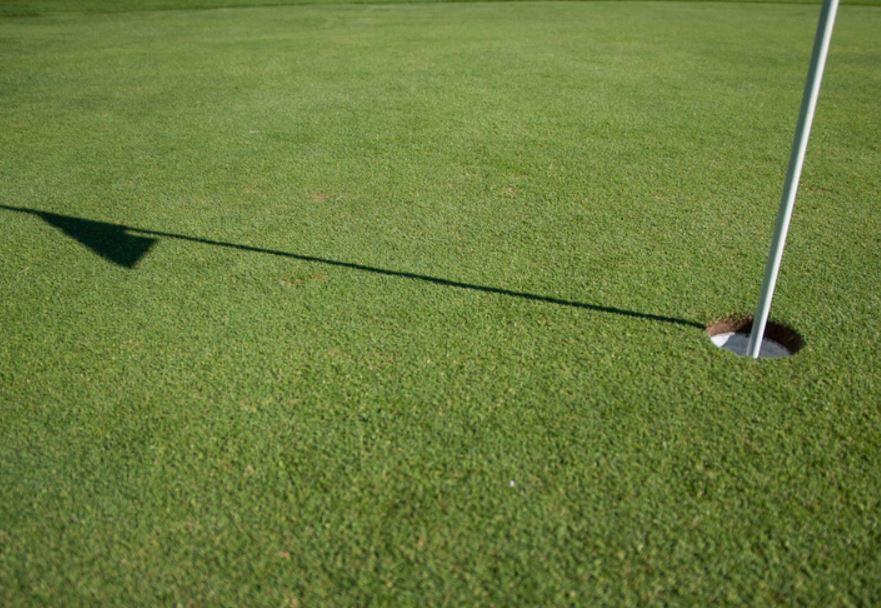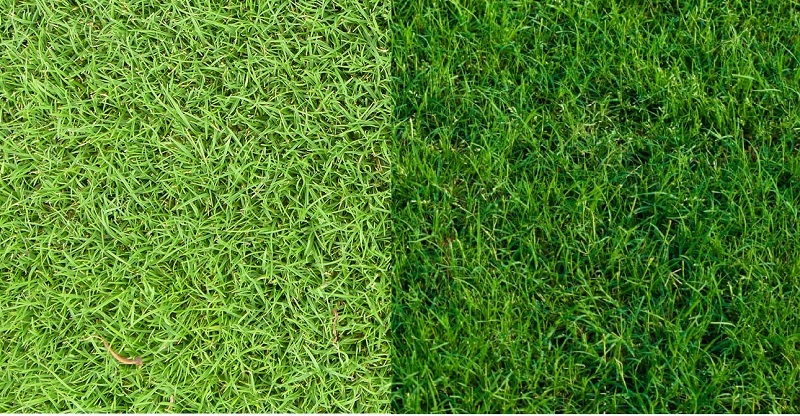Bermuda vs Bentgrass Greens – How They Differ & What’s Better

The grass type of a green is the least discussed factor in putting. However, it is arguably a core element to consider when lining up your putt. In this post, I take you through the characteristics of Bermuda vs Bentgrass greens.
I will explain the differences between each, how they impact your putting, and which is easier to putt on. In addition, I touch on the climates which each grass is better suited for.
Intro To Bermuda vs Bentgrass Greens
Bermuda and Bentgrass greens are the two most common grains used to construct a dancefloor.
Golf Magazine reports that Bermuda greens are slower than Bentgrass, and do not break as much. In addition, Bermuda thrives in warm conditions, while Bentgrass is a cold soul.
Bermuda Vs Bentgrass Green Complete Overview
Bermuda Grass Greens

3 Selling Points
- Less break when putting with the grain
- Thrives in warmer climates
- The color of the grass reveals the direction of the grain
Key Features
Bermuda grass strains thrive in warmer climates and provide a grainy putting surface. That causes your ball to react differently depending on the growth of the grain.
LPGA Pro Maria Fassi says that when Bermuda greens are shiny, it means you are putting with the grain. As a result, the putt will be firm and produce minimal break. Conversely, when the grass presents a dull color, you are putting against the grain and are in for a slow putt that can bobble around.
Where Is It Found?
Bermuda grass is most common in warmer areas. In the United States, you are most likely to find Bermuda greens in the South. I have played on golf courses in South Carolina, Georgia, and Florida that all use Bermuda grass.
Who It Will Suit
Bermuda grass produces varied results depending on the grain. It is fairly easy to detect when you are putting down grain or against it. However, it is a challenging surface to judge when putting against the grain. The ball will deviate in the direction of the grain flow.
All golfers need to know how to putt on all greens, but I find mid to high handicappers struggle on Bermuda. Unless you started playing on Bermuda greens and it is all you know, they are difficult for the average golfer to handle.
What’s Grain In Bermuda Greens – How It Affects Play?
Top 100 Teacher Cheryl Anderson says that the grain of Bermuda grass grows according to the undulation of the green. If the dancefloor is flat, the grass blades grow west. However, if the greens undulate, the blades follow the break of the slope.
Therefore, if putt on a flat Bermuda green and against the grain, you can expect your ball to break from east to west. Those with poor navigation skills can use a compass app if necessary.
Difficulty: 80/100
Check Out More Reviews Here:
Bentgrass Greens

3 Selling Points
- Easier to read
- More consistent
- Suits cooler climates
Key Features
Unlike Bermuda, the grains of its rival grow directly upwards. That means they do not impact the movement of your ball as much as Bermuda grains. However, bentgrass is cut tighter and breaks more. Plus, your ball stays on its line, boosting your consistency.
Thanks to the consistent roll of your ball, bent grass greens tend to measure higher on the stimpmeter than Bermuda.
Where Is It Found?
Bentgrass favors the cooler climates of the world. In the United States, this grass grain is most common in the north of the Country.
Who It Will Suit
The consistency of roll produced by bent grass greens is more favorable to the average golfer. However, you need to master the art of reading breaks in the green for optimal accuracy.
Difficulty: 65/100
Check Out More Reviews Here:
Bermuda Vs Bentgrass Comparison Table
| Grass Varietal | Bermuda | Bent |
| Climate Preference | Warm | Cool |
| Grain Growth | West or With The Slope | Upwards |
| Speed | Slow | Medium |
| Break | Moderate | High |
In What Ways Are They Similar

Genus
Let’s start with a brief science lesson. These grass varieties hail from the same family and order. Bermuda grass, also known as Cynodon dactylon, stems from the Poaceae family and the Poales order.
The scientific name of bentgrass is Agrostis, and it also belongs to the Poaceae family and Poales order.
Turf Grass
In no way am I trying to be funny. The final similarity between these grasses is that they are employed to cover golf greens. Otherwise, they are different animals.
In What Ways Do They Differ
Climate Preference
As I touched on earlier, these grass strains thrive in different climates. Bentgrass is best suited to cooler areas such as the northern United States. Conversely, Bermuda is typically found in warmer zones like Florida.
Grain Growth
Aside from their climate preferences, the biggest difference between these grasses is the growth of their blades. Cynodon dactylon blades grow to the west on flat greens. Conversely, on undulating greens, the grass grows in the direction of the slope.
When putting on these greens, you need to account for the deviation that the grain will deliver. Agrostis grass grows upwards and is smoother than Bermuda. Therefore, the grain does not impact your putt, and your ball stays on the line throughout.
Speed
Bentgrass greens tend to be faster and more consistent than Bermuda greens. The flatter blades encourage a pure roll, which can accelerate the speed of your ball. If you are putting against the grain on Bermuda greens, you can expect slow going. However, when you are down grain, the roll intensifies. As a result, your ball speeds your ball up.
Break
Agrostis grass produces increased break compared to Cynodon dactylon. The grain is flat, and as a result, your ball follows a consistent line. Therefore, if undulation is in play, the ball will break along with it.
When you putt down grain, there is limited break and firmer speed. However, putts against the grain will deviate depending on the direction which the grain bends.
Consistency
Putting on bentgrass produces a pure roll, which keeps your ball on the intended line throughout. Although the break can be challenging to read, you know that your ball will follow the line that you start it on.
Contrarily, Bermuda grass produces different results depending on the growth of the grain. For example, when you putt down grain, the pace is firm. However, the break is minimal. But, putting against the grain produces a slow pace, and the ball can deviate from the intended line.
As a result, Agrostis grass offers increased consistency compared to the erratic Bermuda grain.
Pros Of Bentgrass Over Bermuda

- Consistent
- Smooth
- Easier to read
- It is the best grain for cooler climates
Pros Of Bermuda Over Bentgrass
- It suits warm climates
- Easy to identify the growth of the grain-based on its color
- Reduced break
- Slower speed against the grain
Cons Of Bermuda
- Inconsistent
- They are difficult for the average golfer to read
Cons Of Bentgrass
- Increased break
- The faster speed may be challenging for some golfers to master
What’s Better For High Handicapper

You need to know how to perform on all green types, if you are to become a superior golfer. However, bentgrass is easier to read and more consistent. Your ball endures minimal deviation to keep online for the entire putt.
Mid Handicappers
Mid-handicap golfers, like high handicappers, should perform better on consistent, bent grass greens.
Low Handicappers & Pros
By the time you reach a low handicap, you should excel on Bermuda, Bentgrass, and Poa. If you struggle with any grass, you will find it hard to achieve a low handicap.
Best Course With Bermuda Grass

TPC Sawgrass
The venue for The Players Championship is the best golf course with Bermuda grass. These greens prove a significant challenge for even the best players on the planet. Although slower than bentgrass, they keep the Pros guessing all week.
Best Course With Bentgrass
Augusta National
The venue for the annual Masters tournament tops the list of best golf courses with bentgrass greens. Despite being located in Georgia, a suitable climate for Bermuda grass, the short grass of choice is bentgrass. The grains look and perform optimally in Spring. That is when the first major of the year is hosted.
Conclusion

There you have the rundown on Bermuda vs Bentgrass. Clearly, Bermuda is best fitted to warm climates, while Bentgrass prefers to keep cool. In addition, Bermuda grass tends to be slower than its Bentgrass counterpart.
Furthermore, the blades of Bentgrass grow upwards and present a smooth surface. As a result, the ball is more likely to stay on your intended line. Compared to the erratic nature of Bermuda. Lastly, in the fight between Bermuda vs Bentgrass greens, the latter is smoother and breaks more than dancefloors covered by the former’s blades.
Overall, Bentgrass is more consistent and easier for the average golfer to judge than Bermuda. However, you need to learn how to excel on both surfaces to lower your handicap and become a superior golfer.




